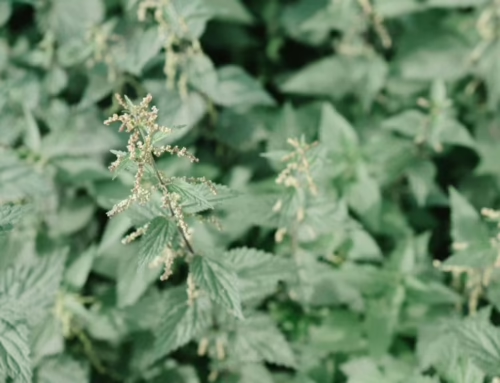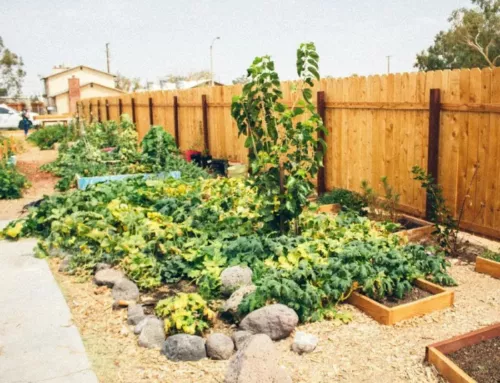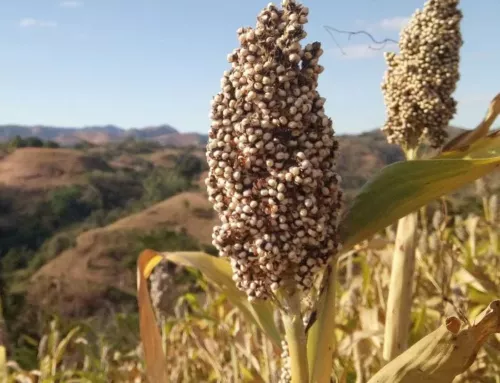By Jade Alicandro Mace
*Reposted with permission. See original article here.
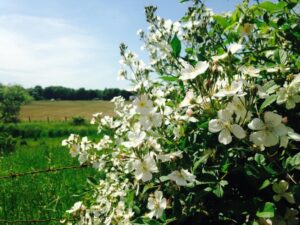
Wild Rose. Photo courtesy Milk and Honey Herbs.
It’s that special time of year again when the Valley is awash with the scent of Wild Rose (Rosa Multiflora). Have you been lucky enough to catch it wafting on the wind like thick perfume?
Anyone who knows me well knows I’m basically obsessed with this plant and with good reason- it’s amazing! I first started thinking about working with it after reading folk herbalist Kiva Rose’s work with the native roses of her New Mexico home. I’ve found our resident Rose to make good and powerful medicine, and have come to rely on it often both in my practice and personally. It’s truly a treasure and such abundant bioregional medicine.
Wild Rose (Rosa multiflora) Materia Medica
Family Rosaceae
Other names: Multiflora Rose, Baby Rose, Seven Sisters Rose, Japanese Rose, Ye Qiang Wei (China/Pin Yin), No-Ibara (Japan), Jjillenamu (Korea)
Part Used: Flowers + Leaves (collected together), Hips, Roots
Habitat: Woodland and field edges, farms, disturbed soil
Description: Medium-sized, climbing, thorned shrub that can form a thicket. Compound leaves with 5 to 9 leaflets and feathered stipules. Multiple white (most common in our area) to pinkish flowers arise on corymbs in early to mid-June, are 2-4 cm in diameter, and have an incredible fragrance. They have the classic Rose Family 5 petals and numerous yellow stamens.
Herbal Ecology: Rose multiflora was introduced to the Northeast in the 1930’s originally to provide wildlife forage in the winter (rose hips), habitat, for soils stabilization, and living fences, and it still provides these ecological benefits to this day. It is now throughout all of the northeast, most of the central states, and the west coast states. In most states where it’s present it’s listed as a “noxious weed,” “exotic,” and/or “invasive,” terms I don’t agree with. It’s not present in the inter-mountain west and Rockies. Originally native to eastern Asia- China, Japan, and Korea. The rose hips do in fact provide excellent winter forage for birds, deer and other wildlife. They also provide excellent shelter and many birds nest in them. It is a plant of edges and seems to protect exhausted agricultural land. It is affected by the Rose Rosette Virus (Emaravirus spp), also called “Witches Broom.” This novel virus has unknown origins but was first identified on roses in the mountains of Wyoming and California in 1930. By the early 2000’s it has spread throughout the entire lower 48, impacting most rose species (wild and cultivars), however R. multiflora seems to be especially susceptible. The virus is fatal and there are no known controls once the plant is fully infected, however early detection and pruning of impacted branches may serve as a control. Removing the plant from the landscape and bagging the infected branches up (not composting) is the best way to control the spread of the disease to other plants. It seems that plants closer that 20 meters of each other are the most likely to be infected (in terms of spreading from plant to plant) and plants that are 150-200 meters apart are at low risk of spreading the virus to each other. The virus is spread by an eriophyid mite (Phyllocoptes fructiphilis) that can be spread through the wind and also on human’s hands, tools, etc. The mites are invisible to the naked eye and commercial miticides do not seem to affect them. I personally have started seeing this virus show-up here in western Mass only in the last few years and have been taking an observation approach to see how much this will impact Wild Rose in terms of ecology and sustainable harvest. My current feeling is that this is an example of a natural check and balance in nature and that we will certainly not see all of our Wild Rose disappear, but we will have to see! At this point I still feel ok about harvesting it because of its abundance, even with the virus effecting some plants, but this will be an ecological situation we will have to keep assessing from year to year.
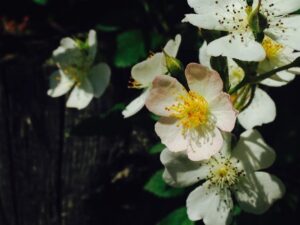
Wild Rose in bloom. Photo courtesy Milk and Honey Herbs.
Collection: Flowers bloom in early-mid June and its season is only about 2 weeks so be sure to harvest before the season passes. The flowers mature at varying rates on the corymb, meaning you will find flowers that just opened (they will have bright yellow stamens), some flowers that are starting to go by (they will have brown stamens), and some flowers still in the budding stage all at the same time. I prefer to harvest the entire corymb, along with one leaflet, and look for corymbs that have plenty of new flowers with yellow stamens but it’s ok if some of the flowers have brown stamens or are in bud- it will be impossible to find a corymb full of just new flowers. Harvesting in the morning will yield the most essential oil-rich harvest. Collect leaves any time before frost. Collect hips anytime after the first hard frost of the season.
Taste: Sweet, Sour, Bitter, Astringent, slightly Pungent
Energetics: Cool, Dry/Contracting. Considered “tridoshic” in Ayurveda, meaning it’s balancing for Vata, Pitta, and Kapha (however may increase Kapha and Ama in excess)
Herbal Actions:
FLOWERS & LEAVES- Anti-inflammatory, Anti-spasmodic, Astringent, Anti-septic, Aphrodisiac, Blood-Mover, Cardiovascular Tonic, Hemostatic/Styptic, Liver Relaxant, Nervine Relaxant, Vulnerary
HIPS- Astringent, Blood Tonic/Nutritive, Immune Tonic, Vulnerary
ROOTS- Astringent
Constituents:
FLOWERS- B Vitamins, Vitamin C, Vitamin K, Carotene, Calcium, Potassium, Anti-Oxidants, Bioflavinoids, Polyphenols, Essential Oils
HIPS- Vit C, Vit A, Vit B1, Vit B2, Vit B3, Niacin, Bioflavinoids, Vit K, Vit E, Polyphenols, Pectin
Uses:
FLOWERS & LEAVES- Powerful vulnerary that reduces pain, heat and inflammation in wounds and helps heal skin abrasions, rashes, bites and stings. Rose is specific for excess heat and is a supremely cooling remedy. Try rose water topically on heat rash, hives, or any other hot skin conditions. A vulnerary that helps heal inflamed and irritated tissue both internally and topically I find Rose to be helpful for recovering from gut inflammation from food intolerance– wonderful in a Gut Heal Tea. Rose is a well-known dermatological aid and is excellent in any and all skin care preparations. I always add Rose petals to my sitz bath formulas for it’s vulnerary and anti-septic properties. Rose works wonders on sunburns and mild burns (especially the diluted vinegar). As an anti-septic and mild antibacterial, Rose makes a great first aid medicine for skin infections. Some of my favorite ways to work with Rose topically for this are the tea, diluted tincture, and rose water. Heart Tonic for the physiological heart and spiritual-emotional heart. Useful for trauma, grief, depression, anxiety (especially heart-based), heartbreak. Moves stuck grief so it can be processed. Heart-opening, and well-known flower of love and devotion that balances heart-opening with protection (thorns). Excellent for boundary work. Cardiovascular tonic, promoting proper vascular functioning, treating high blood pressure and poor circulation, especially when signs of heat are present or symptoms are exacerbated by stress. Antispasmodic helpful for osteoarthritis (“wear and tear arthritis”), sore muscles, chronic musculoskeletal pain, especially topically but helps when taken internally too. Helps promote beneficial bacterial in our guts. Aphrodisiac, helpful for low libido, erectile dysfunction, frigidity, bringing blood flow and promoting circulation to the pelvic region. Relieves menstrual cramps, mood swings and scanty menses resulting from pelvic congestion. Combines well with safflower or hibiscus for this. Helps with an overworked and congested Liver and excess heat in the digestive system. Signs include anger and frustration, diarrhea, constipation, headaches, IBS, gastric inflammation, food allergies and intolerance and sluggish digestion that stems from stuck Liver Qi, especially feelings of quick-t0-rise anger and frustration. As a mild antibacterial, astringent, and vulnerary can be helpful for UTIs, yeast and vaginal infections. Major medicine in Ayurveda and Unani-tibb. Also used in Traditional Chinese Medicine (TCM) and Tibetan Medicine. From an Ayruvedic perspective great for all classic Pitta (excess heat) imbalances, yet is balancing to all the doshas and is considered tridoshic. Ayurveda often combines rose with shatavari as a tonic. . Traditional flower of love and devotion. Used traditionally to make rosary beads, which comes from the latin word rosarium, “rose garden.” Food as medicine– the flowers are edible and are traditionally made into jam in many parts of the world and they can be put into salads, drinks, fruit salads, made into wild soda, icing, and so on. The leaves are edible and can but into salad, added to pesto, etc. Use the honey for sore throats, to stop bleeding and help minor wounds heal or to simply sweeten your tea. Rose is recognized the world over in every major system of herbal medicinal and folk herbal practices everywhere it grows. A panacea and my desert island herb– if I had only one herb to work with in my apothecary it would be rose. Although this post specifically features Rosa multiflora, Rose species all around the world are used medicinally in a similar way. My litmus test- if it smells aromatic then it’s medicinal!
HIPS- Nutritive, rich in Vitamin C and excellent for colds, flus and low immunity. Blood-building, for weakness, fatigue, dry skin and hair (signs of blood deficiency). Rich in bioflavonoids, important for cardiovascular health. Wonderful addition to winter broths. The seeds cause irritation if ingested (but it’s fine to make broth and tea with them, just strain them out) so if you are harvesting them whole be sure to strain them out of a tea or broth, being sure not to ingest the seeds. Food as medicine commonly made into jams, jellies. Can put into immune-boosting herbal bone broths and even into soup! The inner hairs surrounding the seeds can irritate the gut so Rose Hip preparation must either be strained before use or the hulled rose hips must be used if you want to consume them.
ROOTS- Powerful astringent for acute diarrhea and first aid
FLOWER ESSENCE- Protection; those seeking balancing an open heart with having boundaries; Assists one in finding a healthy balance between activity and relaxation. For those who try to over-form their lives; adds a sense of relaxing into the essence of the moment! Wonderful folks who are constantly busy and can’t slow down as a part of a trauma response.
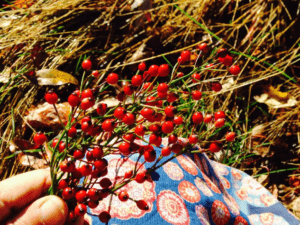
Rosa Multiflora Rose Hips. Photo courtesy Milk and Honey Herbs.
Preparations:
Bath Salts, Cream, Elixir/Cordial, Compress, Flower Essence, Glycerite, Honey, Infused Oil, Infusion, In Food, Liniment, Lotion, Oxymel, Poultice, Salve, Salt or Sugar Scrub, Rose Water/Hydrosol, Ritual Baths, Sitz Bath Tincture, Vinegar, Wild Soda. Liniment-25% Tincture/75% Oil. Tincture-50% Alcohol/ 50% Water. Glycerite- 80% Pure Vegetable Glycerin/20% Water. Elixir-25% Raw Honey/75% Brandy. Vinegar- 100% Raw Apple Cider Vinegar.
Dosage:
Apply oil, salve, cream, liniment, rose water, compress and poultice liberally as needed. Honey- Eat liberally and as needed. Tincture, Glycerite, Elixir- Take ½-1 tsp 3x/day or by the drop as needed. Dilute a few tsp of vinegar in water for burns or use freely on food. Eat freely as food. Rose is a very safe herb!
Contraindications:
Contraindicated in early pregnancy because of blood-moving effects.
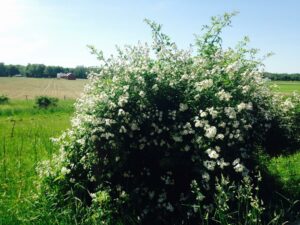
Wild Rose at home. Photo courtesy Milk and Honey Herbs.
References & Resources:
Rose Recipes on this blog:
Wild Rose Elixir
Wild Rose Honey
Beach Rose-Seaweed Mermaid Bath Salts
Rose Oxymel
Herbs for the Spiritual Heart
By Paul Bergner
The Yoga of Herbs
By David Frawley and Vasant Lad
Wild Rose Elixir: A Favorite First Aid Remedy By Kiva Rose
Rose Vinegar: My Favorite Sunburn Soother By Kiva Rose
Rose Monograph By Kiva Rose
World Economic Plants: A Standard Reference, 2nd Edition
By John H. Wiersema, Blanca León

